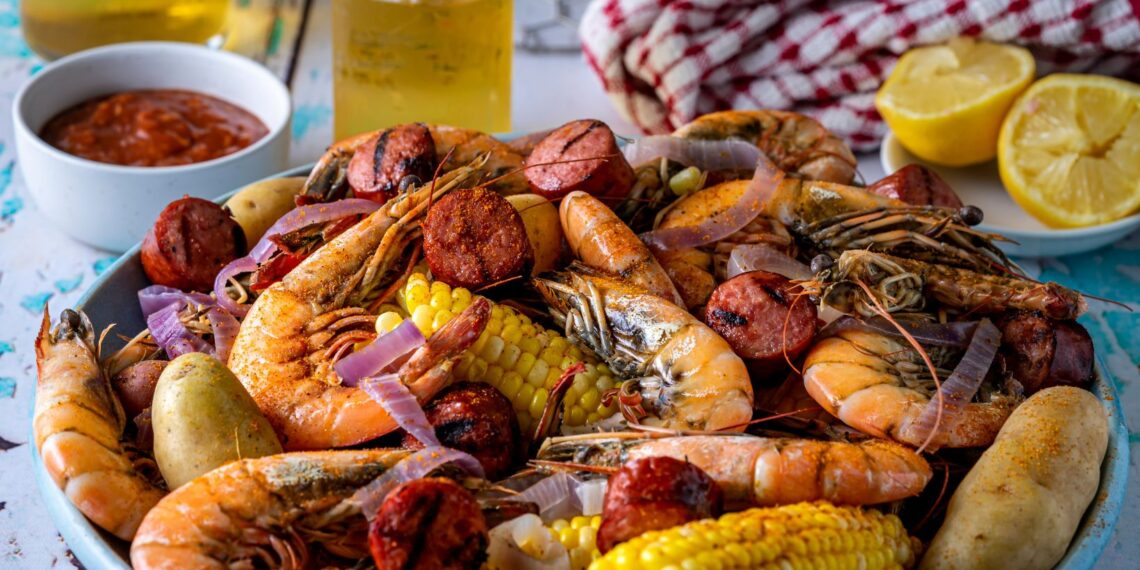Low Country Boil
If you’re looking for a dish that’s steeped in Southern tradition, you’ve hit the jackpot with Low Country Boil. This one-pot wonder is a seafood lover’s dream, featuring a mouthwatering medley of shrimp, corn, potatoes, and sausage.
Originating from the coastal regions of South Carolina and Georgia, it’s a meal that’s as much about the experience as it is about the food. The communal nature of a Low Country Boil, where the feast is often dumped onto newspaper-covered tables, brings folks together like few other dishes can.
What is a Low Country Boil
History of Low Country Boil
Originating from the coastal regions of South Carolina and Georgia, the Low Country Boil has been a staple for generations. Historical records trace this flavorful one-pot meal back to rural, lowland communities. The dish became popular due to its simplicity in preparation and the abundant local seafood. Shrimp season was, and still is, a festive time when communities would come together, throw ingredients into a large pot, and celebrate with a collective feast.
Traditional Ingredients
Low Country Boil, often known as “Frogmore Stew” or “Beaufort Stew”, is a one-pot wonder packed with a myriad of flavors. The dish mainly comprises shrimp, corn-on-the-cob, smoked sausage, and red potatoes. Smoked sausage adds a rich flavor, acting as the backbone of the dish, while the shrimp bring a delicate, seafood taste that’s simply irresistible. The corn and potatoes absorb the delicious broth, rounding out the meal and adding a comforting, hearty element.
Modern Twists
Though the original Low Country Boil is divine in its simplicity, modern adaptations offer intriguing variations on this traditional dish. Some cooks love to add a spicy kick with hot sauce while others prefer the flavor of Old Bay seasoning or Cajun spices. Others may opt for a luxury upgrade by adding crab legs or crawfish, taking the humble Low Country Boil up several notches.
In the culinary world, rules are often meant to be broken. So don’t be afraid to experiment and add your own touch to this beloved Southern classic. After all, the Low Country Boil is more than a dish—it’s an experience, a tradition, a piece of cultural history. It embodies the concept of communal dining, bringing people together over a shared love for food.

How to Prepare a Low Country Boil
Gathering Fresh Ingredients
While each family may have their own favorite ingredient to add, one factor remains critical—freshness of the produce. Whether it’s the shrimp, corn-on-the-cob, smoked sausage, or red potatoes, selecting the freshest varieties is key. Don’t compromise on the quality of the ingredients. While local seafood markets are the best bet for acquiring fresh shrimp, the rest of the produce can be sourced from your local farmers’ markets. With the modern twists, you can also consider adding other fresh seafood like crab legs or crawfish. Just remember – the fresher the ingredients, the better the flavors in your Low Country Boil.
Seasoning the Boil
Seasoning gives the boil its distinctive taste and kick. For the Low Country Boil, Old Bay seasoning is a tried-and-true choice. For those who favor spicy food, adding a dash of cayenne pepper or hot sauce can provide that extra punch. Don’t shy away from experimenting with various seasonings to suit your taste pallet. This step is all about personalization; after all, seasoning can make or break your boil.
Cooking the Boil
When it comes to cooking the Low Country Boil, timing is crucial. To ensure each ingredient is cooked perfectly, add them in stages based on the cooking time they require. Begin with the ingredient that takes the longest to cook – often, it’s the potatoes followed by the corn, the sausage, and finally adding the shrimp in the end. Don’t overcook – the goal is to retain the original flavors of each ingredient.
Serving the Boil
Traditionally, this delightful dish is served directly onto the dining table, still piping hot from the pot. Diners gather around and eat straight off the paper-covered table, relishing the steaming pile of cooked southern delicacies. The traditional Low Country Boil is finished off with ice-cold sweet tea – it’s not just a dish, but a communal dining experience.
There you have it – the essential steps to preparing and truly enjoying a Low Country Boil. Whether you stick to the traditional recipe or put on a personal spin, remember, at the heart of a Low Country Boil lie the principles of simplicity, fresh ingredients, and shared culinary joy. Embrace these, and you’re set on your way to make a memorable Low Country Boil.














